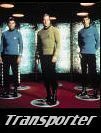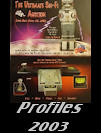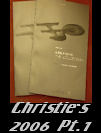The transporter device, which made its first appearance in “The Cage” (1964) - the pilot episode for Star Trek, was an ingenious creation that, according to The Star Trek Encyclopedia (Pocket Books, 1994) “briefly converts an object or person into energy, beams that energy to another location, then reassembles the subject into its original form.” Its usage in The Original Series was a necessity to help the Desilu production team control budget, as discussed by TOS Assistant Director and later Co-Producer Robert Justman in the book “Inside Star Trek: The Real Story” (Pocket Books, 1996) …
My other major worry (the first being no gravity in outer space, which was “solved” by Gene Roddenberry’s decision to equip the Enterprise with it’s own artificial gravity field) was the enormous cost of optical effects to land the Enterprise on a new planet every week. Gene’s clever solution: the transporter effect, “beaming” people to other locations with no apparent loss of molecules, other than when required for story purposes.
When I first viewed the transporter effect, I was as curious as anyone else might be and asked the inventive Darrell Anderson how he achieved it. Darrell said, “I just turned a slow-motion camera upside down and photographed some backlit shiny grains of aluminum powder that we dropped between the camera and a black background.”
And using a piece of Sandy Courage “shimmer” music, we gave the visual effect its distinctive sound. Gene’s creative solution to my “landing” dilemma resulted in a new catch-phrase and a wealth of bumper stickers, “Beam me up, Scotty.”
Incidentally, the exact words “Beam me up, Scotty” were never spoken in the dialogue of a TOS episode. A typical command might be “Mr. Scott, one to beam aboard.”
A full technical description of the film editing process involved in creating the Transporter effect is provided by Stephen Whitfield in “The Making of Star Trek” (Ballantine Books, 1968) …
The dematerialization and rematerialization of crewmen (the Transporter Effect) is accomplished as follows:
- The crewman to be transported steps into the transporter and is filmed.
- As the camera continues to run, the crewman steps out of camera range and the empty set is filmed. Later, the action of the man leaving the set will be clipped out of the film … and the footage spliced into one piece.
- On a duplicate piece of film shot in 2, above, a mask, exactly outlining the person’s figure as he appeared in the transporter, is superimposed, creating a piece of film with a “hole” in it.
- These pieces of film are then rephotographed simultaneously in the optical printer:
a. The original film.
b. The masked film.
c. A length of film containing only the glitter effect of the transporter. To obtain the “glitter effect”, aluminum dust was photographed as it was dropped from overhead, falling through a beam of high-intensity light. - The “glitter effect” goes through the “hole” in the second piece of film and thus coincides with the outline of the crewman. When the film is run, the man is slowly “faded” out of the picture, momentarily leaving the glitter effect in place of his body. The glitter is then faded (“dissolved”) out as well.
In TOS, it was established that transporters are unable to function when deflector shields are raised. Transporter malfunctions were also the source of some extraordinary storyline developments in The Original Series. In the first season episode “The Enemy Within”, for example, a mishap during a routine transport aboard ship causes both a “good” and “evil” Kirk to be created. Fortunately, Scotty manages to diagnose the problem and use the device to reassemble the Captain into his original form and rescue a stranded landed party on the verge of freezing to death. In the popular second season episode “Mirror, Mirror”, it is another transporter accident, triggered by an unexpected ion storm, that causes the landing party to exchange places with identical “barbarian” counterparts from a parallel or mirror universe, that were in the act of beaming back to their ship at the same instant in time.
In Star Trek: The Next Generation, the audience is provided with more details on the underlying operating theory and some of the critical technical components of the device. Specifically, in the TNG episodes “The Hunted” and “Power Play”, the annular confinement beam or ACB is introduced. As described in The Star Trek Encyclopedia, it is “a cylindrically shaped forcefield used to insure that a person being transported remains within the beam. Failure to remain within the confinement field can cause a dangerous release of beam energy, possibly fatally injuring the transport subject and those nearby.” Transporter Pattern Buffers played a significant role in the famous TNG episode “Relics”, which featured a guest star appearance of actor James Doohan reprising his role as Montgomery Scott. As described in The Star Trek Encyclopedia, the pattern buffer was a key transporter component “in which a transport subject’s image is briefly stored so that transmission frequency can be adjusted to compensate for the Doppler effect caused by any relative motion between the transport chamber and the target. Because of the criticality of this subsystem, two buffers must be operated in synchronization with each other so that in case of failure of one unit, the beam can be immediately handed off to the backup.” Scotty successfully modified the pattern buffers of the U.S.S. Jenolen in “Relics” so that he was able to survive for 75 years in a suspended state awaiting rescue by the USS Enterprise-D.
One of the most often cited reasons why some scientists believe that the development of a “real” working transporter may be impossible has to do with an important and central part of quantum mechanics called the Heisenberg Uncertainly Principle. This principle states that it is impossible to know with absolute certainly both the location and motion vector of a subatomic particle (for example, an electron orbiting a nucleus in a target atom); although, any one of the two characteristics, either the location or the vector of the particle, may be precisely known. A transporter device would have to be able to derive the exact positional and vector data of all of the subatomic particles in the subject being “beamed” in order to reassemble the person or object at the destination location. In Star Trek: The Next Generation, there is mention of a Heisenberg Compensator – another key piece of transporter technology – but no detailed explanation of its operating theory is provided.
Complications with Transporters in the ST:TNG years were also possible. A somewhat interesting affliction called “Transporter psychosis” is described in The Star Trek Encyclopedia as follows:
Transporter psychosis. Rare medical disorder caused by a breakdown of neurochemical molecules during transport. Transporter psychosis was first diagnosed in 2209 by researchers on planet Delinia II. The condition affected the body’s motor functions, as well as autonomic systems and higher brain functions. Victims were found to suffer from paranoid delusions, multi-infarct dementia, tactile and visual hallucinations, and psychogenic hysteria.
No wonder why Dr. McCoy had his reservations about stepping into the Transporter chamber during the feature film years!
Below are some photos of the Transporter Chamber and the Transporter Console as seen in TOS. (Not all Star Trek fans may know that the floor discs used in The Original Series transporter chamber were reused in the production of TNG and Voyager and were, in fact, installed as the ceiling discs for those transporter chambers.) …










































































































